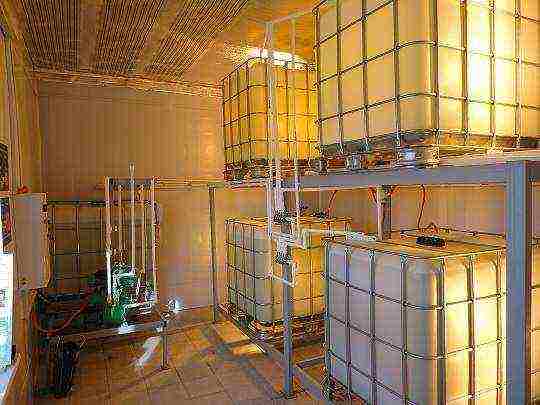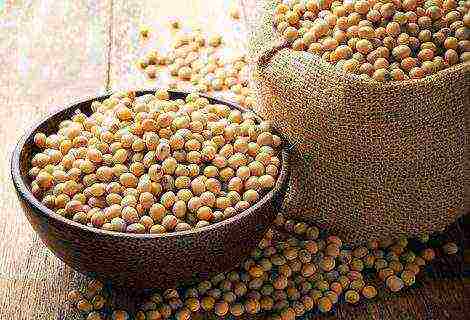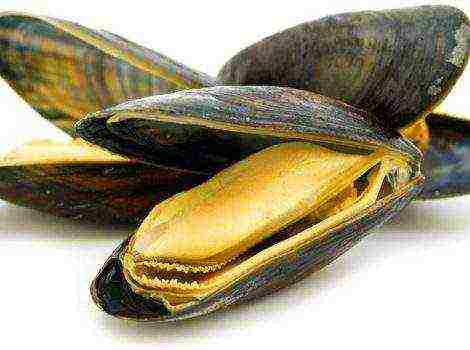Content
(from the Do-it-yourself fish farming section of our photo album)
Growing microalgae spirulina and chlorella for feeding fish and crustaceans when organizing a home fish farm: a description of the technology for growing microalgae, especially feeding fish fry and adult fish, advice on composing a balanced diet for fish and other questions on feeding fish.
Chlorella growing plant
scheme of the installation for growing chlorella, photoreactor for cultivating chlorella
Photoreactor - an aquarium 1 * 1 * 0.04 m (40 liters) high, in which glass partitions were placed to increase the path traversed by water. Water from the pool was pumped through the aquarium ...
More details
Growing chlorella
how to grow chlorella microalgae with your own hands
Spirulina and Chlorella are microalgae that are used as a bioactive food supplement as a comprehensive life support system for sturgeon.
1. Culture Chlorella C- ...
More details
Growing spirulina in the pool
how to grow spirulina microalgae in the pool
The selected pool area must be in an open area. Sizes may vary. In the construction of swimming pools, as a basis, you can use bricks, cinder blocks ...
More details
Growing Spirulina Microalgae
what conditions are necessary for growing spirulina, how to grow spirulina microalgae
The liquid used to make spirulina is a solution of mineral salts in water. This liquid should provide spirulina with all the chemical elements it needs ...
More details
Growing chlorella as a business
Why Chlorella, Chlorella Growing Business
The properties and qualities of chlorella have been thoroughly studied. Scientists have found 15 vitamins in it. In terms of its nutritional value, algae is not inferior to meat and is significantly superior to wheat. If in wheat ...
More details
Growing chlorella in a sturgeon basin
the results of growing chlorella in the sturgeon pool
Three cultures were inoculated onto the water taken from the sturgeon basin: Spirulina platensis, Chlorella vulgaris C-1 and an unidentified filamentous form (blue-green) isolated from ...
More details
Features and conditions for growing chlorella
growing chlorella with your own hands, what conditions are needed for growing chlorella
In working cultivators of a closed type, the temperature is automatically maintained at the level of 20-28 ° C and constant lighting. They are supplied with a nutrient solution of a certain composition with a pH ...
More details
Pay attention to the following categories:
| Do-it-yourself Koi carp farming
Do-it-yourself breeding of Koi carps and other types of ornamental fish for artificial reservoirs and aquariums: advice on choosing a place, shape and size of a reservoir for breeding ornamental fish, for the care, feeding and reproduction of Koi carps |
| Sturgeon breeding business
Private business for breeding sturgeon for meat and caviar: features of arranging artificial pools for home breeding of Russian and Siberian sturgeon, sterlet, hybrid bester of the Aksai breed of sturgeon, advice on care and feeding, necessary conditions for breeding, description of the method of "milk" to obtain caviar from females |
| Diy trout farming
Tips and instructions for trout farming: trout breeding in artificial stakes, ponds and pools, especially arranging reservoirs for growing trout with your own hands, organizing care and feeding, providing conditions for breeding and other recommendations for growing trout |
| Breeding carp, crucian carp and tench
Home business for breeding carp, crucian carp, tench and other simple types of river fish: tips for organizing your fish production, further processing and marketing of finished products.Calculating the profitability of a small business for growing fish in an artificial reservoir with your own hands |
| Eel Breeding Business
Description of the technology of growing eels in closed water supply installations and circulating water supply systems: the advantages and disadvantages of each method of growing eels in artificial reservoirs, the peculiarities of providing standard conditions for breeding, keeping and feeding. Production of cured and smoked eel, advice on the sale of finished products |
| Growing spirulina and chlorella
Growing microalgae spirulina and chlorella for feeding fish and crustaceans when organizing a home fish farm: a description of the technology for growing microalgae, especially feeding fish fry and adult fish, tips on composing a balanced diet for fish and other questions on feeding fish |
| Growing Artemia
Features of the technology of growing brine shrimp crustaceans: the level of water salinity in the incubation tank and maintaining the required temperature, conditions for long-term storage of brine shrimp eggs, ensuring the availability of nutrients (microalgae) in the water for the growth of brine shrimp and other issues on feeding fry and adult fish with brine shrimp nauplii |
You may be interested to see:

The productivity of large workshops for year-round cultivation of chlorella is up to 40 tons of suspension per day. A typical plant for growing chlorella usually looks like a greenhouse and consists of a production cultivation room, a laboratory, a warehouse for chemicals and carbon dioxide cylinders, and a room for preparing solutions. The general scheme of the production process for growing chlorella consists of the stages of preparation of nutrient and gas media, preparation of inoculum, cultivation of algae, delivery of finished products, washing and disinfection of technological equipment.
Inoculums are prepared in the laboratory, which are then fed to production cultivators. 1 ml of inoculum contains 1-3 million chlorella cells. In industrial cultivators, the initial density of the suspension is 2-5 million, the final density is at least 100-150 million cells in 1 ml.
In working cultivators of a closed type, the temperature is automatically maintained at the level of 20-28 ° C and constant lighting. They are supplied with a nutrient solution of a certain composition with a pH of 6-7. The solution contains various macro- and microelements. The gas mixture supplied to the cultivator contains up to 2% carbon dioxide. The contents of the cultivator are continuously mixed. In 1 liter of suspension, an average of 3-5% of dry matter of algae is accumulated. In open cultivators, the density of the suspension is less. Their use increases the dependence of the process of growing chlorella on weather conditions. In such cultivators, it is advisable to grow mesophilic strains of algae that can withstand temperature fluctuations from 5 to 30 ° C.
Different technologies for growing chlorella envisage the use of not only carbon dioxide in cylinders and nutrient solutions based on mineral salts, but also the use of organic, organo-mineral mixtures, and liquid manure as sources of mineral nutrition.
In Tatarstan, one of the first, in the USSR, they began to use a suspension of chlorella in animal feed: in the Arsk and Zelenodolsk regions.
Long-term use of chlorella by livestock farms:
Bashkyrtystan, Penza, Kirov, Volgograd, Saratov, Sverdlovsk regions, confirmed its highest efficiency as a feed additive. Moreover, chlorella, being a probiotic, makes it possible to abandon feed antibiotics as therapeutic agents, thereby excluding the ingress of antibiotics into animal products.
Energotekhnoprom LLC manufactures and assembles bioreactors for growing chlorella suspension and creating complete feed in each individual farm.For the cultivation of chlorella, units BR-1000, BR-4000, BR-10000, BR-12000 are used with a capacity of 800, 3200, 8000 and 9600 liters of suspension per day, respectively. Products and equipment were demonstrated at the visiting board of the Ministry of Agriculture, held in February and July 2009, at a seminar in February 2011. and March 2012 in RT. Its implementation is underway in a number of farms in Tatarstan.
Chlorella bioreactor BR-1000 is an installation of 5 containers of 1000 liters each for a suspension of chlorella with light sources, and is equipped with other devices that provide optimal conditions for the reproduction of chlorella in a special nutrient medium. The set of the installation also includes a set of reagents for the preparation of a nutrient medium and a suspension of the mother culture of chlorella.
Energotekhnoprom LLC produces units from 1000 liters of chlorella suspension per day (BR-1000) to 12000 liters per day (BR-12000). It is possible to produce plants with the highest production capacity.
The principle of operation of the installations is based on the use of the light factor as a necessary condition for photosynthesis and growth of chlorella in a special nutrient medium in a certain temperature range. The general cycle of the bioreactor is four full days (until the required density of cells in suspension increases), it consists of three stages:
• launching the bioreactor into operation;
• cultivation of chlorella;
• draining the finished chlorella suspension and preparing the bioreactor for the next run.
The actual cultivation of chlorella is reduced to maintaining the temperature of the suspension in the bioreactor vessel in the optimal range, periodically adding carbon dioxide to the suspension up to once a day and monitoring the rate of increase in cell density and the general state of the chlorella suspension.
Biotechnology training is carried out in 2 hours, and maintenance of one installation in time takes 1-2 hours a day. The requirements for the premises used are simple: the minimum temperature in winter must be at least 22 degrees, with a voltage of 380 V.
The cost of biotechnology training, the use of chlorella and culture media reagent kits for 4 cycles is included in the cost of the installations. In the future, reagent kits are sent to farms in advance by mail in accordance with the agreement.
The use of chlorella suspension in animal feed diets allows farms to comprehensively solve the problem of increasing productivity in animal husbandry:
- to sharply reduce the mortality of young animals to 2-5%,
- to increase the weight gain for fattening cattle and pigs from 30% to 40%;
- to increase the milk yield of cows by 20-30%, significantly extending the period of economic use of animals;
- to reduce the number of unproductive inseminations and the terms of the service period;
- to receive a healthy offspring with high vital energy;
- by strengthening the immune status and increasing the resistance of the animal's body, birds will completely get rid of such diseases as tuberculosis, vitamin deficiency, pneumonia, leg diseases, etc., dramatically reduce the cost of veterinary drugs;
- by increasing the digestibility of feed, save their consumption up to 22%;
- to improve the quality of livestock products.
With the regular introduction of a suspension of chlorella into fish ponds, the number of forage aquatic organisms increases, the hydrochemical, especially oxygen regime of reservoirs improves, which increases the productivity of fish ponds in polyculture (thick milk, grass carp, carp, carp, etc.) up to 40%. Effectively using a suspension of chlorella in greenhouses, increases the germination of seeds when soaked in a suspension of chlorella, increases productivity, and reduces the readiness of vegetables and fruits.
The use of our technology will allow you to:
• solve the most important problem of balanced feeding rations;
• become independent from suppliers of expensive feed additives;
• to achieve a solution to a complex of zootechnical and veterinary problems;
• receive high quality and environmentally friendly products;
• and as a result - to significantly increase the profitability of your farm.
Also, we are ready to present economic data when using chlorella suspension obtained in various farms of the agro-industrial complex in the Republic of Tajikistan.
Prices for installations in the Republic of Tatarstan:
BR-1000 RUB 580,000
BR-4000 RUB 1,200,000 BR-10,000 RUB 1,700,000 BR-12,000 RUB 1,900,000
The invention relates to the field of growing chlorella. A method for growing chlorella is proposed. The method involves placing a chlorella suspension in two glass containers, in which there are heaters with thermostats to maintain an optimal temperature of 28 ± 2 ° C. A source of artificial light is located between the containers; a phytoluminescent lamp is used as a source of artificial lighting. A system of two parallel copper electrodes covered with an insulating material is placed in the container, to which a high voltage direct current of 10-60 kV is applied to create an electrostatic field. The invention improves the efficiency of the process of growing chlorella. 2 ill.
The invention relates to the microbiological industry, in particular to the technology of growing chlorella.
A known method of growing microalgae chlorella, which provides for the cultivation of microalgae on a liquid nutrient medium under stirring and lighting conditions when exposed to a pulsed low-frequency electromagnetic field with a magnetic induction of 2000 Gs at a pulse frequency of 10 Hz and a duration of 10 μs (SU 1711734 A1). The disadvantages of this method include low productivity.
The technical result of the proposed method is to increase the productivity of growing chlorella while maintaining the required quality.
The technical result is achieved by the method of growing chlorella, which includes placing a suspension of chlorella in two glass containers, in which there are heaters with thermostats to maintain an optimal temperature of 28 ± 2Cº, a light source is located between the containers, and, moreover, a phytoluminescent lamp is used as a light source, the system is placed in the container of two copper electrodes covered in parallel, covered with insulating material, to which a direct current of high voltage 10-60 kV is applied to create an electrostatic field.
New essential features:
1. The use of phytoluminescent lamps provides a more favorable radiation spectrum for chlorella.
2. Exposure to the electrostatic field has a beneficial effect on the growth of chlorella.
The listed set of features provides a technical result in all cases covered by the requested scope of legal protection.
The authors studied the dependence of microalgae growth on the type of lighting.
The experiment on the effect of different light sources on the rate of reproduction of chlorella cells was carried out under identical conditions with the same initial concentration of cells in suspension.
As can be seen from the above dependences, the use of a phytoluminescent lamp provides a greater increase in the density of microalgae cells in solution as compared to a conventional fluorescent lamp.
FIG. 1 shows a graph of the dependence of the increase in the cell density of the chlorella suspension on the type of light source.

For comparison in laboratory conditions, the installation was recreated according to patent SU 1711734 A1.
The electromagnetic field is generated by an alternating current source, while the electrostatic field is generated by a direct current source.
Alternating current periodically changes its strength and direction over time, unlike direct current.
As can be seen from the graph, the use of an electrostatic field to stimulate the culture of microalgae significantly increases the productivity of the installation, in comparison with the use of an electromagnetic field.
The experimental results are shown in FIG. 2.

A method for growing chlorella, including placing a suspension of chlorella in two glass containers, in which there are heaters with thermostats to maintain an optimal temperature of 28 ± 2 ° C, an artificial light source is located between the containers, characterized in that a phytoluminescent lamp is used as a source of artificial lighting, in the container is placed a system of two copper electrodes covered in parallel, covered with an insulating material, to which a direct current of high voltage 10-60 kV is applied to create an electrostatic field.


